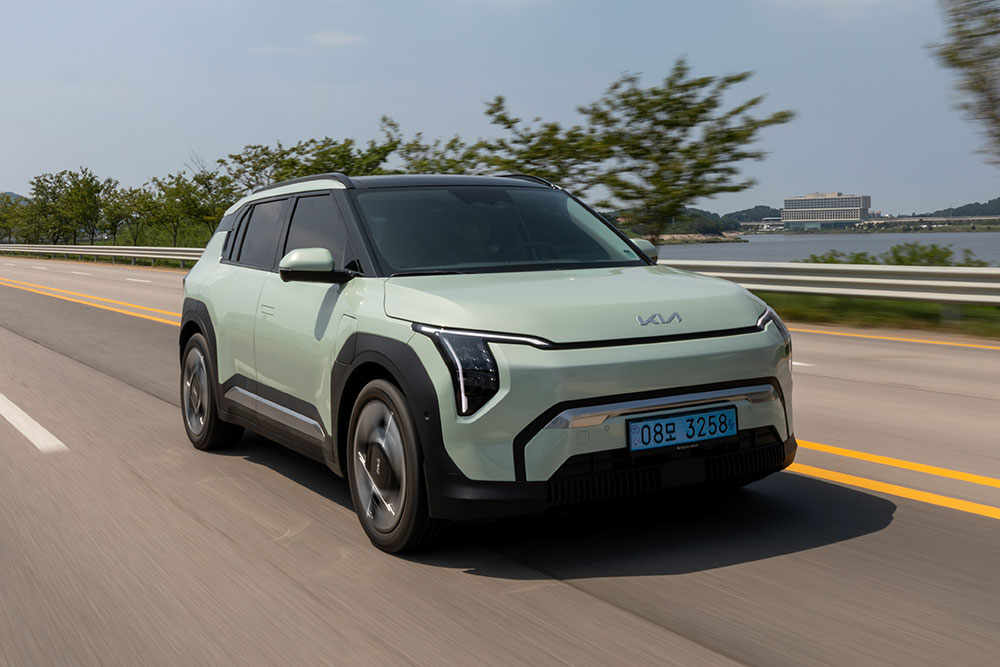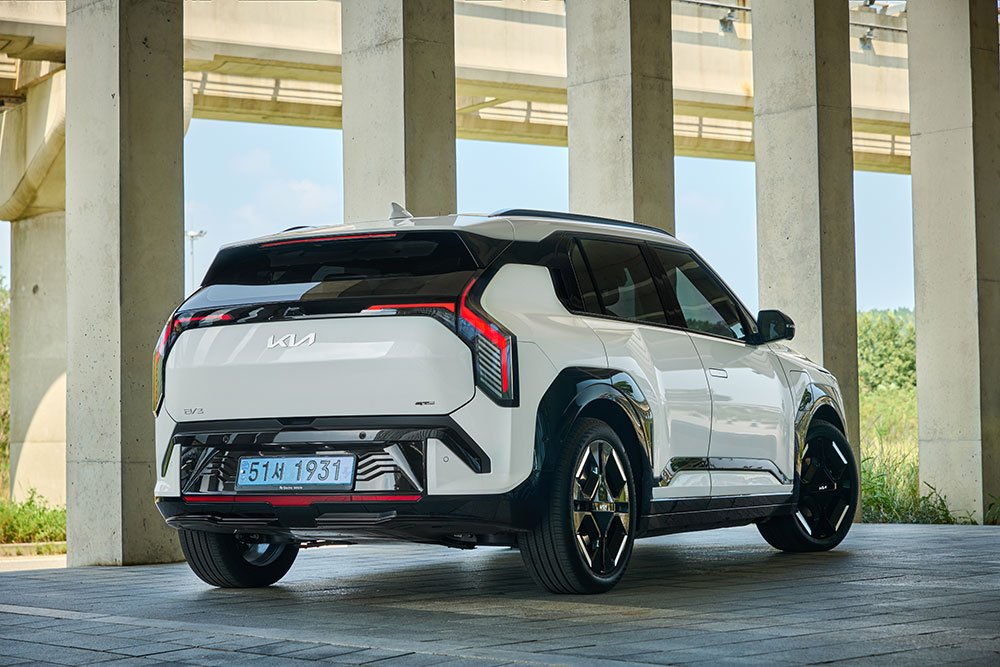Kia’s new EV3 impresses with price and range
Kia’s new baby electric SUV boasts impressive range and an attractive price.

Kia Australia has confirmed pricing and features for its all-new compact electric SUV, with the entry-level EV3 set to launch with a sub-$50,000 price and a more expensive Long Range variant capable of traveling more than 600km on a single charge.
The EV3 arrives in dealerships in April and will slot into Kia’s lineup below the existing EV9, EV6 and EV5, going head-to-head with the likes of the BYD Atto 3, Smart #1 and #3, MG4, Volvo EX30 and others.
Quick links
- What is the range and cost of the EV3?
- What is powering the EV3?
- What about the EV3's exterior design?
- What is it like inside the EV3?
- Does the EV3 have any special features?
What is the range and cost of the EV3?
The range opens with the EV3 Air Standard Range with 58.3 kWh battery priced at $47,600 RRP ($48,990 driveaway).
Stepping up to the EV3 Air Long Range with larger 81.4 kWh battery hikes the price to $53,315 ($56,490 driveaway) but improves range from the entry model’s 436km (WLTP) to an impressive 604km on the WLTP cycle.
Further up the range come the EV3 Earth Long Range and EV3 GT-Line, both featuring the same 81.4kWh battery as the Air Long Range, and priced at $58,600 ($62,690 driveaway) and $63,950 ($68,490 driveaway).
Both these variants have a claimed range of 563km (WLTP).

What is powering the EV3?
All four EV3 variants feature the same single motor front-wheel drive powertrain, with identical outputs of 150kW/283Nm, with the larger 81.4 kWh battery available on the three Long Range variants.New regenerative braking technology
Helping optimise the driving range of all EV3 variants is Kia’s new iPedal 3.0 adjustable regenerative braking system, which the company claims takes the concept of one-pedal driving to the next level by offering the driver more flexibility and control.
By separating the level of regenerative braking from the full stopping control function, the EV3’s full one-pedal driving can be used in all regenerative braking modes, whereas in many vehicles it will only work in the strongest regeneration mode.
The i-Pedal 3.0 can also be used in Reverse and remembers the previously selected level when the vehicle is turned off.
The EV3 will also be the first to feature Hyundai Motor Group’s Smart Regenerative System 3.0 technology, which integrates autonomous driving technology with regenerative braking, using GPS technology to scan the road ahead and react to situations more quickly.
What about the EV3’s exterior design?
Stylistically, the EV3’s aerodynamic shape has been enhanced via extensive wind tunnel testing with Kia pointing to the SUV’s optimised wheel shapes, new side sill undercovers, and clean underbody, all of which contribute to cleaner underfloor airflow and reduced drag.
Other aero enhancements include optimised headlamp and front bumper covers, wheel gap reducers, an optimised wheel arch design, a shallower roof spoiler angle, aerodynamic strakes on the rear bumper cover and improved front wheel deflectors.
The EV3’s body is also narrower across the rear wheel arches than the front wheel arches, creating a boat-tail shape that further contributes to its improved electric driving range.
The front-end design of Kia’s new compact EV incorporates the car maker’s Star Map lighting and Tiger Face family elements, with the GT-Line distinguished by stronger opposing diagonal elements and a larger, black lower grille for a sportier appearance.
The GT-Line also gets unique front and rear lighting elements and its own 19-inch alloy wheel designs, with the Earth riding on a different 19-inch design and the Air variants rolling on 17-inch alloys.
Other notable exterior design elements include flush front and hidden rear door handles, while inside the EV3 features a minimalistic design with soft touch points and large touchscreen displays.

What is it like inside the EV3?
The packaging benefits of the EV3’s dedicated EV platform is claimed to deliver optimised interior space within a compact exterior, benefitting legroom, shoulder room and headroom.Front seat passengers have extra space thanks to a compact HVAC (heating, ventilation and air-conditioning) system, which Kia claims provides an extra 6cm of room in the footwell when compared with a conventional HVAC system.
Cargo space is also claimed to be generous for the small SUV class, with 460L VDA area in the rear and an additional 25L VDA cavity in the nose of the EV3.
Comfort and convenience features include Kia Connect, Over the Air updates, wireless Apple CarPlay/Android Auto and phone charging, V2L including connector kit, a column-type Shift-by-Wire gear selector. The higher specified Earth and GT-Line trims are also equipped with a Smart Power Tailgate.
Over and above this, the EV3 GT-Line gets a Head-Up Display (HUD), sunroof, and eight-speaker Harman Kardon sound system.
All grades feature a 12.3-inch Digital Driver Cluster, 5.3-inch Climate Monitor, and 12.3-inch Touch Screen Infotainment interface, with Kia’s latest GUI (Graphical User Interface).
A Driving Range Guide located in the instrument cluster helps drivers achieve maximum efficiency and range, switching colours in real time to indicate if the EV3 is being driven efficiently or not.
Does the EV3 have any special features?
Kia claims the EV3 raises the bar for what’s expected of a compact electric model with features including 350kW DC fast charging capability, and the ability to power or charge external devices, such as camping equipment.
Kia claims the EV3’s liquid-cooled battery reduces rapid charging time by up to 12 minutes over the Niro EV, enabling the Long Range model to charge from 10–80% in 31 minutes on a 350kW fast charger.
The EV3’s Vehicle-to-Load (V2L) feature also enables the car to power and charge external devices such as a laptop or small fridge while ‘off-grid’ from electric infrastructure.
Related topics
Things to note
The information in this article has been prepared for general information purposes only and is not intended as legal advice or specific advice to any particular person. Any advice contained in the document is general advice, not intended as legal advice or professional advice and does not take into account any person’s particular circumstances. Before acting on anything based on this advice you should consider its appropriateness to you, having regard to your objectives and needs.
Insurance Products (excluding Travel Insurance) are issued by RACQ Insurance Limited ABN 50 009 704 152 (RACQI) and arranged by its agent, RACQ Distribution Services Pty Ltd (RDS) ABN 35 116 361 650, AFSL 567130 and RDS' authorised representatives (including RACQ Operations Pty Ltd ABN 80 009 663 414, AR No. 234978 (RACQO). Conditions, limits and exclusions apply. RDS and RACQO are in the RACQ group of companies. One of the companies in the RACQ group of companies has a minority shareholding in RACQI.
RDS and RACQO have not taken your personal objectives, circumstances or needs into account when preparing advice regarding insurance products and you will need to consider whether the advice is appropriate for you. Read the Product Disclosure Statement (PDS) and any applicable Supplementary PDS before making a purchase decision on this product. You can also access our Target Market Determinations on this website. RDS receives a commission from RACQI for the policies it arranges. RACQO receives fees paid for services it provides to RDS. Further details about remuneration are available on request prior to purchasing.
Banking and loan products issued by Members Banking Group Limited ABN 83 087 651 054 AFSL/Australian credit licence 241195 trading as RACQ Bank. Terms, conditions, fees, charges and lending policies apply. This is general advice only and may not be right for you. This information does not take your personal objectives, circumstances or needs into account. Read the disclosure documents for your selected product or service, including the Financial Services Guide and the Terms and Conditions, and consider if appropriate for you before deciding.
Except for RACQ Bank, any RACQ entity referred to on this page is not an authorised deposit-taking institution for the purposes of the Banking Act 1959 (Cth). That entity’s obligations do not represent deposits or other liabilities of RACQ Bank. RACQ Bank does not guarantee or otherwise provide assurance in respect of the obligations of that entity, unless noted otherwise.
RACQ Bank subscribes to the Customer Owned Banking Code of Practice which establishes higher standards than the law requires. The Code reflects modern consumer expectations and developments in approaches to issues such as consumer vulnerability, guarantors, and supporting customers through financial hardship. Please read our Customer Owned Banking Code of Practice page for more information.
RACQ Operations Pty Ltd (ABN 80 009 663 414 AR 000234978) and Members Travel Group Pty Ltd (ABN 45 144 538 803 AR 000432492) are acting as an Authorised Representative of the issuer of the insurance, Tokio Marine & Nichido Fire Insurance Co., Ltd. (ABN 80 000 438 291 AFSL 246 548). Any advice set out above is general in nature only, and does not take into account your objectives, financial situation or needs. Before purchasing any travel products, please consider the RACQ Travel Insurance Product Disclosure Statement (PDS) and the Target Market Determinations (TMDs) that apply to these products. Whilst the PDS outlines the Terms and Conditions of these products, the TMDs outline the intended class of customers that comprise the target market for these travel products. This will allow you to consider which products best suit your objectives, financial situation and needs and consider the products appropriateness to your personal circumstances. TMDs also outline matters involving the distribution and the review of these products. The PDS, Supplementary PDS and TMDs for each travel product can be found here.

